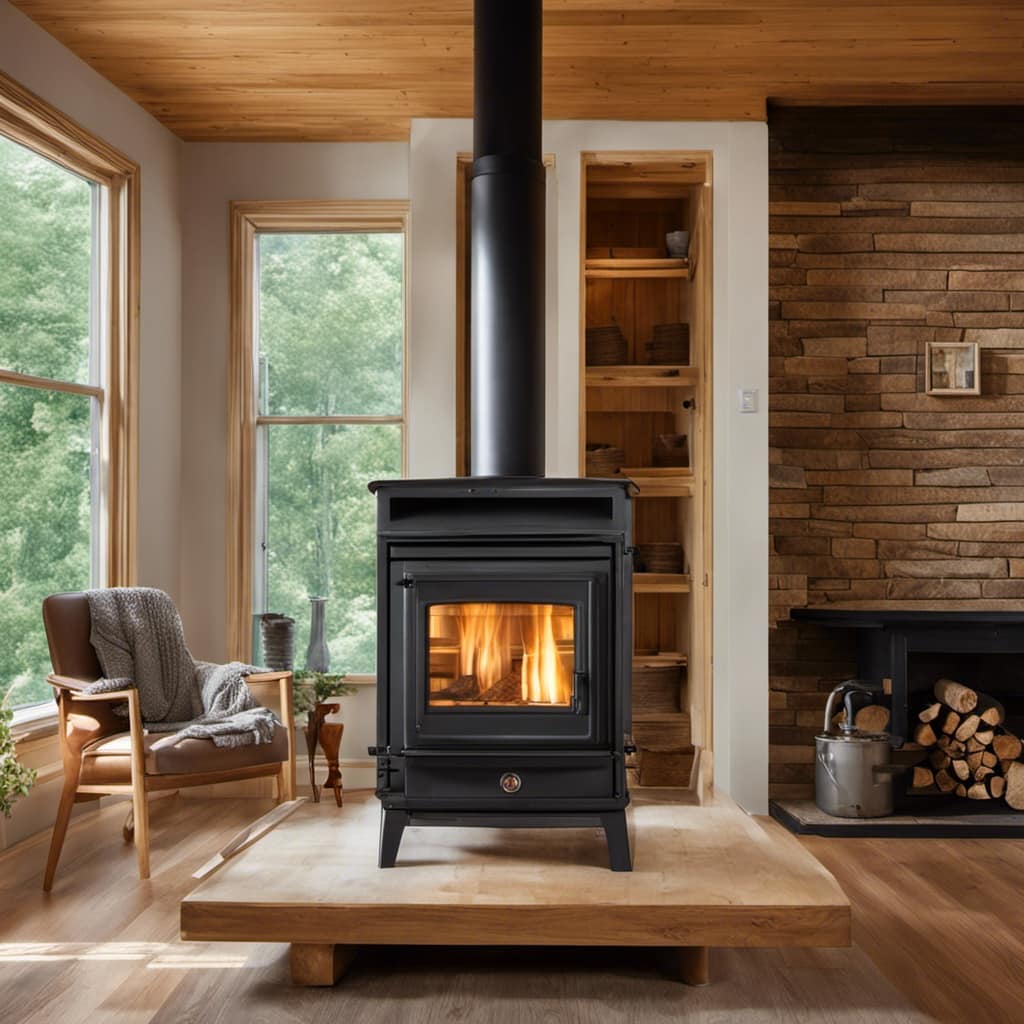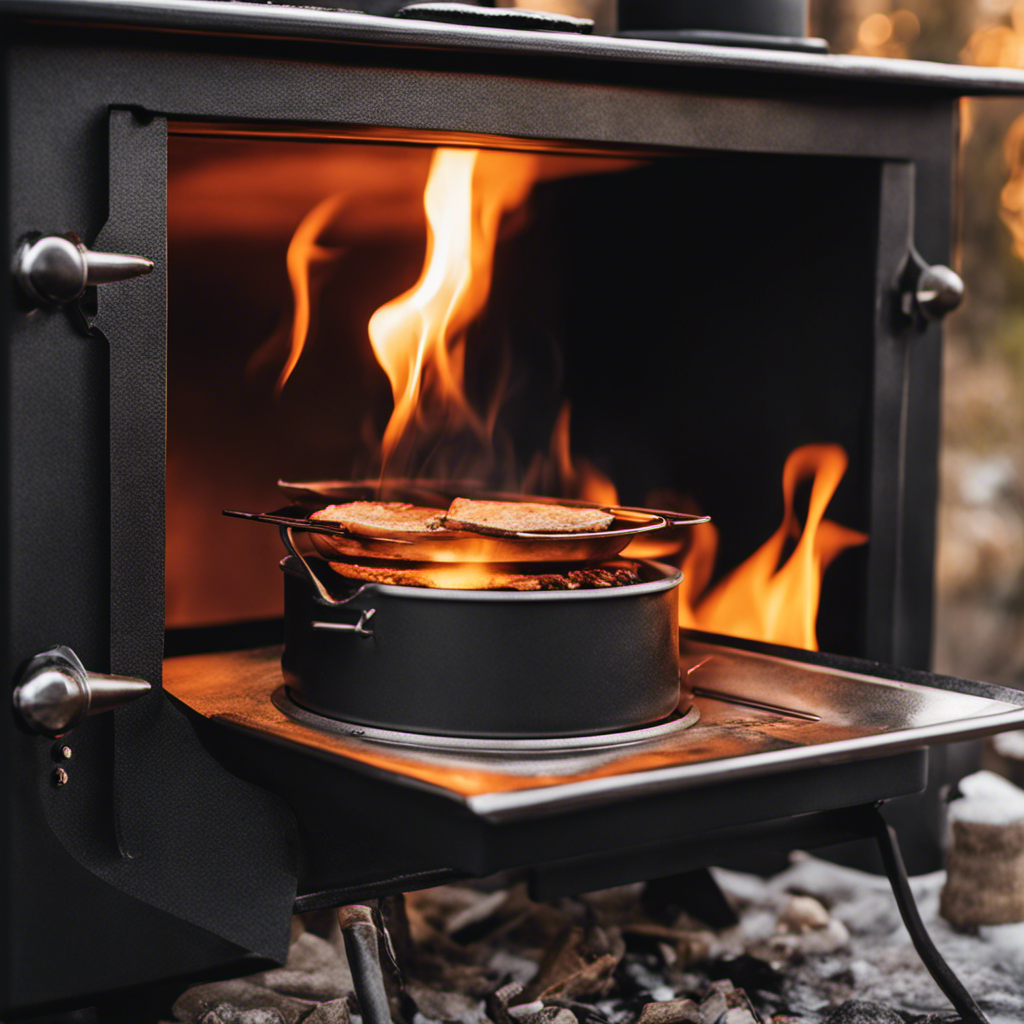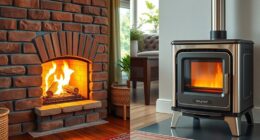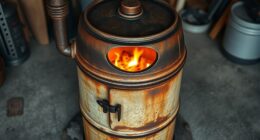Secondary combustion plays a crucial role in modern wood stoves by enhancing efficiency and reducing emissions. It reintroduces smoke gases into a hot firebox, allowing for complete combustion at high temperatures, which results in up to 80% combustion efficiency. This process not only generates more heat with less wood but also cuts emissions by as much as 90% compared to traditional stoves. With either catalytic or non-catalytic designs, these stoves meet EPA standards and support sustainable heating practices. If you're curious about how these systems work and their benefits, there's plenty more to explore.
Key Takeaways
- Secondary combustion reintroduces smoke gases into a hot firebox, achieving complete combustion and enhancing heating efficiency.
- It significantly boosts heat output while reducing emissions by up to 90% compared to traditional wood stoves.
- Modern stoves achieve combustion efficiency ratings of 80% or higher, leading to lower wood consumption for equivalent heat.
- Two main types, catalytic and non-catalytic, utilize different mechanisms to support environmental sustainability and carbon neutrality.
- Compliance with EPA standards ensures these stoves promote cleaner air quality and responsible wood burning practices.
Understanding Secondary Combustion
Secondary combustion plays an essential role in the efficiency of modern wood stoves. When you burn wood, the initial combustion releases smoke gases, which can be reintroduced into a hot area of the firebox. This process, known as secondary combustion, ignites those gases at temperatures around 1,100°F, allowing for complete combustion.
By effectively burning these gases, you not only boost heat output but also greatly reduce emissions. Additionally, incorporating eco-friendly practices in your heating methods can further enhance sustainability.
Wood stoves equipped with secondary burn technology often feature burn tubes and baffles that help mix smoke with pre-heated air. This mixing enhances combustion and leads to more efficient burning of wood.
When secondary combustion occurs successfully, you'll notice clear smoke from the chimney, indicating that the stove is operating efficiently. Conversely, if you see visible smoke, it suggests incomplete combustion and inefficiency in your stove's operation.
With effective secondary combustion, modern wood stoves can meet stringent EPA regulations and achieve up to 80% combustion efficiency. Understanding this process is important for optimizing your stove's performance and minimizing your environmental impact.
Benefits of Secondary Combustion

Experiencing the benefits of secondary combustion in modern wood stoves can transform your heating efficiency. By utilizing a secondary burn, these stoves combust gases released during the initial wood burning process, leading to a more complete burn. This means you get more heat output while using less fuel, resulting in efficient energy use.
Additionally, this technology aligns with principles seen in design thinking approaches, emphasizing user-centered solutions that cater to both comfort and environmental sustainability.
One of the most significant advantages is the dramatic reduction in emissions. With secondary combustion, you can enjoy lower emissions—up to 90% less compared to traditional stoves. This not only helps meet stringent EPA regulations but also contributes to cleaner air quality in your home and community.
Moreover, modern wood-burning stoves can achieve combustion temperatures around 1,100°F, which is vital for maximizing heat while minimizing the release of unburned particles and smoke.
With combustion efficiency rates reaching up to 80%, the combination of primary and secondary combustion processes guarantees you're making the most out of your wood fuel.
Ultimately, adopting a stove with secondary combustion technology aligns with environmental sustainability goals, offering a carbon-neutral heating solution comparable to naturally rotting wood. You'll not only stay warm but also support a healthier planet.
Mechanism of Secondary Burning

Modern wood stoves harness the power of secondary combustion to enhance heating efficiency and minimize emissions. This process occurs when gases released from burning wood are reintroduced into a hot area of the fire box, igniting at temperatures around 1,100°F.
For instance, wood pellet stoves like the Englander 10-Cpm utilize advanced combustion techniques to achieve high efficiency and low emissions, making them an excellent choice for eco-conscious homeowners Best Small Wood Stoves.
Here's what makes secondary burning effective:
- A baffle system redirects smoke and gases through burn tubes.
- Continuous secondary air supply mixes smoke with oxygen.
- Clear chimneys and visible flames indicate efficient combustion.
With these elements in play, secondary combustion markedly boosts combustion efficiency ratings up to 80% or higher, compared to traditional wood-burning stoves.
The baffle system guarantees that gases linger longer in the fire box, allowing for thorough ignition and producing additional heat. Meanwhile, the continuous secondary air supply is essential for mixing, guaranteeing ideal conditions for effective secondary burning.
Indicators of success include a clear chimney and flames that visibly consume gases, showing a reduction in unburned particles in emissions.
Types of Secondary Burn Stoves

When choosing a wood stove, you'll find two main types of secondary burn stoves: catalytic and non-catalytic.
Catalytic stoves use ceramic combustors to re-burn waste gases, enhancing combustion efficiency and achieving high heat output. They tend to meet strict EPA emissions standards, markedly lowering pollutants compared to older models. Additionally, utilizing wood stoves can contribute to sustainable practices through efficient fuel use and reduced carbon emissions.
However, these stoves require more maintenance, such as regular cleaning and combustor replacement, which you should consider.
On the other hand, non-catalytic stoves rely on longer smoke paths for complete combustion. While they're generally easier to operate and maintain, their combustion efficiency is slightly lower than that of catalytic models.
Both types play a vital role in supporting environmental sustainability by achieving carbon neutrality similar to naturally rotting wood.
Popular models like the Ecosy+ Panoramic9 and Ecosy+ Ottawa 5 ECO are available in various outputs, priced between £379.00 and £679.00.
When selecting a secondary burn stove, think about your specific needs and preferences, whether you prioritize efficiency, ease of maintenance, or emissions standards. Each type has its advantages, so choose the one that best fits your lifestyle and environmental goals.
Installation and Maintenance Considerations

Choosing the right wood stove is only the beginning; proper installation and ongoing maintenance are key to maximizing performance and safety. To guarantee you get the most out of your stove, consider the following:
- Follow manufacturer guidelines for clearance from walls and furniture.
- Schedule regular maintenance to prevent creosote buildup.
- Install smoke and carbon monoxide detectors nearby. Effective keyword clustering can also help you discover relevant topics related to wood stove safety and efficiency.
A professional installation is highly recommended. This guarantees correct venting, preventing smoke and carbon monoxide from accumulating in your home, which enhances the effectiveness of secondary combustion.
Additionally, it's essential to comply with EPA certification standards when selecting your wood stove. This not only helps maintain air quality but also makes sure you're adhering to local regulations.
Regular maintenance is equally important. Cleaning the chimney and inspecting stove components will help maintain peak functioning of the secondary combustion system and prevent hazardous situations.
Environmental Impact of Secondary Combustion

Harnessing the power of secondary combustion, wood stoves have become a more environmentally friendly heating option. This innovative technology considerably reduces particulate emissions by up to 90% compared to traditional models, leading to improved air quality in your home and the environment.
Additionally, advancements in heat pump technology, such as innovative heat exchangers, can further enhance energy efficiency in heating systems. By igniting smoke gases at higher temperatures, secondary combustion helps achieve carbon neutrality, meaning the carbon output is similar to that of naturally decomposing wood.
With an efficiency rating of around 80% or higher, these stoves require less wood for the same amount of heat, which decreases overall wood consumption. This efficiency not only benefits you economically but also supports sustainable heating practices.
Modern wood stoves equipped with secondary combustion technology comply with stringent EPA emissions standards, drastically cutting harmful pollutants released into the atmosphere.
Frequently Asked Questions
Is Secondary Burn Good for a Wood Stove?
Yes, secondary burn's great for your wood stove. It enhances efficiency, reduces emissions, and maximizes heat output. You'll use less wood while enjoying a cleaner burn, making your heating experience more effective and environmentally friendly.
What Does a Secondary Air Tube Do in a Wood Stove?
A secondary air tube in your wood stove introduces pre-heated air into the combustion chamber, igniting unburned gases. This process enhances efficiency, reduces emissions, and maximizes heat output, making your stove cleaner and more effective.
Which Is Better Catalytic or Secondary Burn Wood Stove?
Choosing between catalytic and secondary burn wood stoves is like picking a favorite star in the night sky. If you prefer efficiency and simplicity, go for the secondary burn. If you want peak performance, choose catalytic.
What Is a Secondary Air Intake on a Wood Stove?
A secondary air intake on a wood stove boosts combustion efficiency. It introduces more oxygen into the chamber, allowing unburned gases to ignite, resulting in cleaner burns and reduced emissions while enhancing heat output.
Conclusion
So, you thought burning wood was just about tossing logs in a fire? Ironically, it's a whole science! With secondary combustion, you're not just keeping warm; you're actually making a positive impact on the environment while enjoying that cozy glow. Who knew that your rustic wood stove could be an eco-friendly hero? By embracing this modern twist, you're not only heating your home but also indulging in a cleaner, more efficient way to enjoy nature's bounty.











